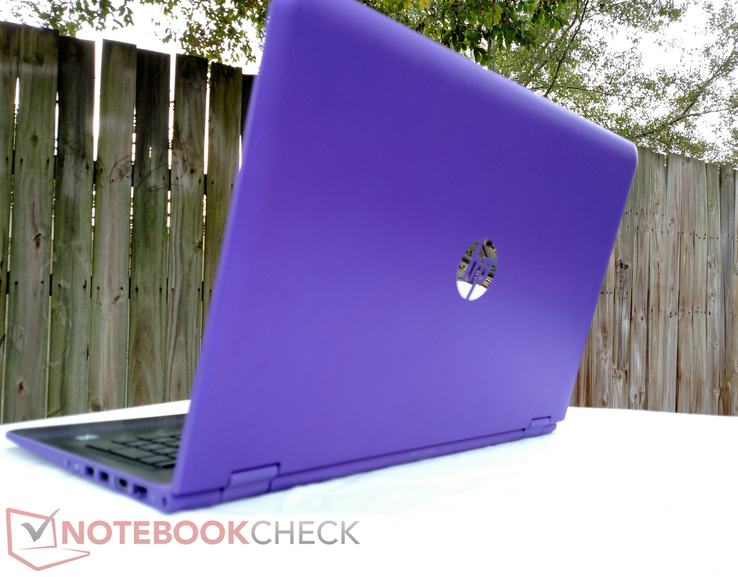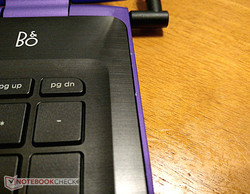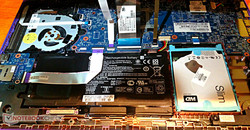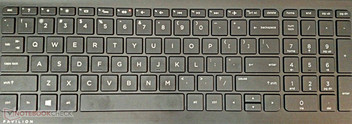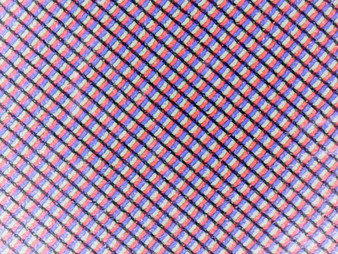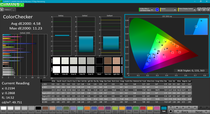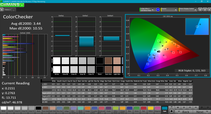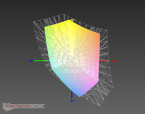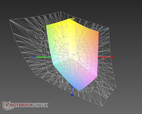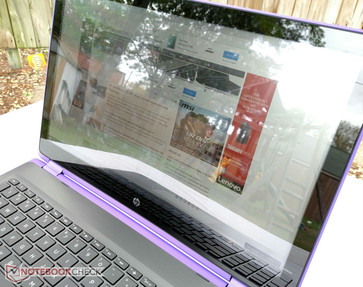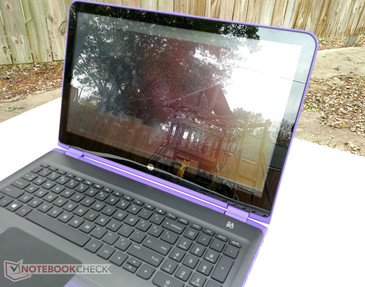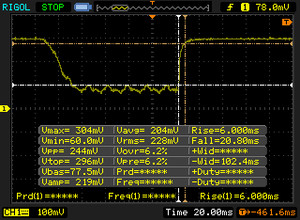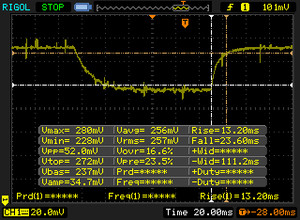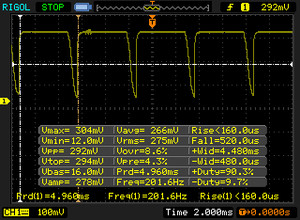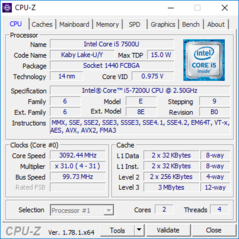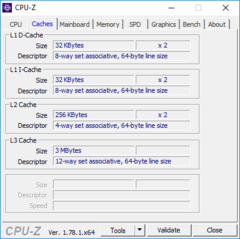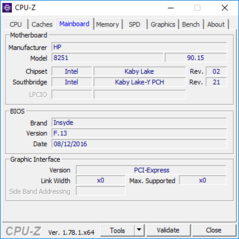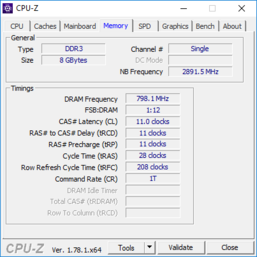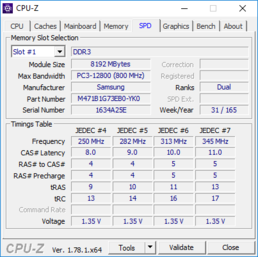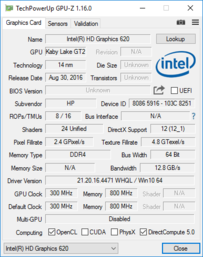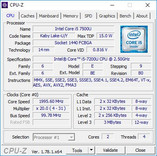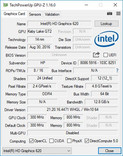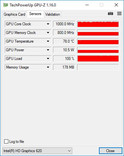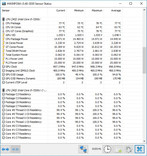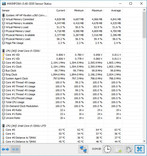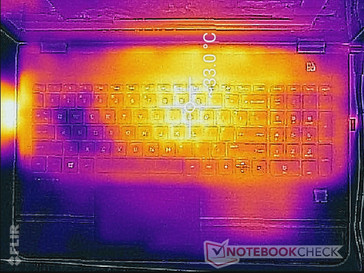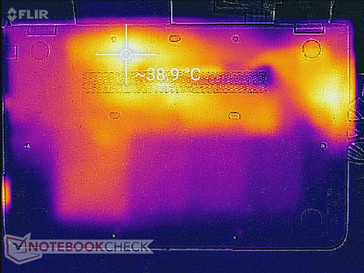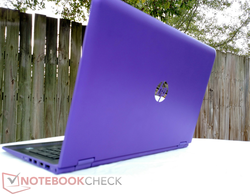HP Pavilion x360 15t X3W72AV Convertible Review

Kaby Lake has arrived in HP’s x360 convertible notebooks. While the updated Spectre x360 is geared for power users, the Pavilion x360 line is targeted at consumers who want a 2-in-1 notebook at a lower price point. The Pavilion x360 15t is the largest of HP’s hybrids. We looked at the Skylake version of this device not too long ago and now revisit the 15-inch Pavilion x360 to see what improvements the upgrade to Kaby Lake may bring.
Our review unit is equipped with an Intel 7th Generation Core i5-7200U and new Intel HD Graphics 620 GPU but bears the same 8 GB of RAM and 1 TB HDD of its older brother. Our configuration currently retails on HP’s site for US $799. Potential buyers looking to save some money can opt for the more affordable i3-7100U, 4 or 6 GB of RAM, and a 1366 x 768 resolution display for as low as US $540. There are also 11- and 13-inch variants available from HP.
This review will mainly focus on the differences between our Kaby Lake model and the earlier Skylake version (HP Pavilion 15-bk001ng). Competitors like Lenovo have not been content to rest on their laurels and have upgraded their Yoga line to Kaby Lake as well; as such, we will also compare our Pavilion x360 to the updated versions of Lenovo's devices: the Lenovo Yoga 510-15IKB and the Lenovo Yoga 710-14IKB. We will also compare the Dell Inspiron 15 5568, another 15-inch convertible.
Case
The chassis remains unchanged from its plastic predecessor save for the color options. In addition to a standard silver finish (dubbed “Natural Silver”), the device is now available with some very bold color options ("Cardinal Red" and "Sport Purple") for an extra $10. Our review unit wears the Sport Purple finish, and the color is striking and definitely sticks out in a crowd. The matte finish is quite prone to nicks and scratches, however; our review unit showed some noticeable wear and tear after a few weeks of use.
Although the chassis is covered in plastic, it remains fairly firm. When the keyboard deck and base are pressed, they do not creak. The center of the lid can be easily depressed (especially when applying pressure to the logo in the middle), but the display housing doesn't flex or twist much at all. The underside remains stable under pressure and shows no major distortion. The keyboard deck is firm as well. Despite constant pressure, the keyboard barely moves, and there is no flex at all while typing. Gaps around the keyboard are visible, but small.
The hinges are sturdy and hold the screen in place while typing with absolutely no wobble. However, if touch input is used, the screen bounces a bit but soon resets itself to the original position. Magnets are used to hold the lid to the base when the notebook is closed or in tablet mode, so two hands are needed to open it. The hinges allow the screen to rotate full-circle, turning the notebook into a tablet. This motion is smooth and easy.
The device is rather large and very heavy for tablet use; the Inspiron 15 5568 and Yoga 710-15IKB are about 0.23 kg (0.5 lbs) lighter despite being the same size. Our Pavilion is difficult to hold in tablet mode for extended periods of time.
Size Comparison
The newer Pavilion x360 is the same size as the older and not significantly different than the other machines. The Dell is slightly larger, although the increase in size is minimal. The Lenovo Yoga 710-14IKB definitely has the smallest footprint of the notebooks but also has a smaller 14-inch screen.
Connectivity
The upgrade to Kaby Lake has left the port layout untouched. The device is equipped with three USB Type-A ports (one of which is USB 2.0), HDMI, a combo audio jack, and a Gigabit Ethernet port. While there is ample connectivity, it would have been nice to see a USB Type-C port on this device. Unfortunately, the modern port is still absent.
SD Card Reader
The SD-card reader is very deep and inserted cards sit flush with the side. Using our Toshiba Exceria Pro SDXC 64 GB UHS-II Reference-Card, we measured speeds similar to those in our last test. The device still sits above average for its category and handily beats the Dell Inspiron with read and write speeds that are over three times faster.
| SD Card Reader | |
| average JPG Copy Test (av. of 3 runs) | |
| HP Pavilion 15-bk001ng x360 | |
| Lenovo Yoga 510-15IKB 80VC000XGE | |
| HP Pavilion x360 15t X3W72AV | |
| Lenovo Yoga 710-14IKB 80V4002HGE | |
| Dell Inspiron 15 5568 | |
| maximum AS SSD Seq Read Test (1GB) | |
| HP Pavilion x360 15t X3W72AV | |
| Lenovo Yoga 510-15IKB 80VC000XGE | |
| HP Pavilion 15-bk001ng x360 | |
| Lenovo Yoga 710-14IKB 80V4002HGE | |
| Dell Inspiron 15 5568 | |
Communication
The Pavilion x360 is equipped with an Intel 802.11 ac 1x1 wireless card with integrated Bluetooth 4.2. Due to compatibility with both 2.4 GHz and 5 GHz bands, WiFi connections are rock solid. In our signal test, our device achieves a receiving rate of 344 MBit/s and a sending rate of 309 MBit/s. This is fairly close to the theoretical cap of 433 MBit/s and is more than quick enough for day to day use. Streaming media should be no problem, but large file transfers over wireless connections may take time.
| Networking | |
| iperf3 transmit AX12 | |
| Dell XPS 13 9360 FHD i5 | |
| HP Pavilion x360 15t X3W72AV | |
| HP ProBook 455 T1B79UT | |
| iperf3 receive AX12 | |
| Dell XPS 13 9360 FHD i5 | |
| HP Pavilion x360 15t X3W72AV | |
| HP ProBook 455 T1B79UT | |
Maintenance
Maintenance can be rather difficult. There are twelve Phillips-Head screws on the underside, but only four are visible. Six screws can be found under the rubber feet of the device, while two more are hidden underneath plastic tabs that are secured with adhesive. Be warned: in removing these tabs, the chassis can easily be nicked. Once the screws are out, the internals can be accessed by unclipping the keyboard deck.
Exercise caution when taking the keyboard out. The plastic clips holding it in place can be easily broken, and the borders of the housing can be scratched without much effort. There are also three thin ribbon cables attaching the keyboard to the main board. These need to be disconnected before performing any maintenance.
The only components that can easily be swapped are the HDD, battery, and wireless card. The RAM module can be upgraded, but further disassembly is required. The CPU is soldered to the motherboard.
Input Devices
Keyboard
The keyboard is greatly improved from the last model. Our current test unit has a U.S. layout with a number pad. The arrow keys feel cramped as the up and down arrow keys are half the size of the left and right. The keyboard now includes a feature sorely missed from our previous unit: a backlight. There is only one level, but the white light is sufficiently bright and makes the keyboard legible in the dark. Note that the backlight is not included by default; it must be added at the time of purchase for an additional $30 US.
As we noted in our earlier review, the keys are soft and don’t clatter. There is a low, hollow “thump” when we forcibly and quickly typed. Keys are responsive and register every press but are a bit mushy and suffer from a short drop and undefined stop. Overall, typing is a much better experience than before, and the keyboard is more than passable. While professional typists may not be thrilled to use this keyboard for long sessions, it definitely gets the job done.
The keyboard deck has one major enemy: fingerprints. Finger and palm oils seem to immediately stick to the key surfaces upon contact and can take some effort to wipe off.
Touchpad
The touchpad is rather hit or miss. The plastic has a slight texture on it that provides adequate friction while remaining unobtrusive, but the touchpad doesn’t always register tracking. We were not sure if this was a problem with our particular unit, but it was distracting nonetheless. Two-finger scrolling also registered inconsistently, leading to some frustrating experiences. Left- and right-clicks are consistent, but the touchpad sounds hollow and doesn't feel very sturdy. Users will regularly find themselves opting to navigate via the touchscreen.
Touchscreen
The touchscreen is a delight. It is highly responsive and immediately recognizes multitouch gestures. While the trackpad is frustrating, the touchscreen is a great option for input and navigation. The hinges wobble slightly when touch is used, but the screen is quick to stabilize.
Display
The new unit has the same IPS panel as before, and the 1920x1080 resolution remains unchanged. The average maximum brightness of 210.7 cd/m2 is a minor improvement, but still lags behind the competition. There is some noticeable bleed from the backlight along the bottom of the display.
Response times are decent but fall short of rivals'. The PWM frequency is also fairly low and may cause some eye strain after long periods of use.
| |||||||||||||||||||||||||
Brightness Distribution: 84 %
Contrast: 641:1 (Black: 0.36 cd/m²)
ΔE ColorChecker Calman: 4.58 | ∀{0.5-29.43 Ø4.78}
ΔE Greyscale Calman: 2.94 | ∀{0.09-98 Ø5}
64% sRGB (Argyll 1.6.3 3D)
41% AdobeRGB 1998 (Argyll 1.6.3 3D)
44.3% AdobeRGB 1998 (Argyll 3D)
63.8% sRGB (Argyll 3D)
42.8% Display P3 (Argyll 3D)
Gamma: 2.18
CCT: 6233 K
| HP Pavilion x360 15t X3W72AV Chi Mei CHMN15D3, IPS, 15.6", 1920x1080 | HP Pavilion 15-bk001ng x360 Chi Mey CHMN15D3, IPS, 15.6", 1920x1080 | Lenovo Yoga 510-15IKB 80VC000XGE BOE HF NV156FHM-N42, IPS, 15.6", 1920x1080 | Lenovo Yoga 710-14IKB 80V4002HGE AU Optronics B140HAN03.0, a-Si WLED TFT, IPS, 14", 1920x1080 | Dell Inspiron 15 5568 AU Optronics B156HW01 V0, IPS, 15.6", 1920x1080 | |
|---|---|---|---|---|---|
| Display | -2% | -2% | 43% | -11% | |
| Display P3 Coverage (%) | 42.8 | 41.84 -2% | 41.92 -2% | 62 45% | 38.04 -11% |
| sRGB Coverage (%) | 63.8 | 62.7 -2% | 62.9 -1% | 89.5 40% | 57.1 -11% |
| AdobeRGB 1998 Coverage (%) | 44.3 | 43.25 -2% | 43.32 -2% | 63.3 43% | 39.3 -11% |
| Response Times | 17% | -21% | -34% | 2% | |
| Response Time Grey 50% / Grey 80% * (ms) | 36.8 ? | 30.8 ? 16% | 53 ? -44% | 53 ? -44% | 42 ? -14% |
| Response Time Black / White * (ms) | 26.8 ? | 22 ? 18% | 26 ? 3% | 33 ? -23% | 22 ? 18% |
| PWM Frequency (Hz) | 201.6 ? | 200 ? | 50 ? | 50 ? | |
| Screen | 13% | 20% | 0% | 9% | |
| Brightness middle (cd/m²) | 230.8 | 225 -3% | 236 2% | 340 47% | 266 15% |
| Brightness (cd/m²) | 211 | 210 0% | 212 0% | 302 43% | 249 18% |
| Brightness Distribution (%) | 84 | 85 1% | 78 -7% | 77 -8% | 85 1% |
| Black Level * (cd/m²) | 0.36 | 0.22 39% | 0.18 50% | 0.31 14% | 0.26 28% |
| Contrast (:1) | 641 | 1023 60% | 1311 105% | 1097 71% | 1023 60% |
| Colorchecker dE 2000 * | 4.58 | 4.13 10% | 3.92 14% | 6.75 -47% | 4.98 -9% |
| Colorchecker dE 2000 max. * | 11.23 | 9.36 17% | 9.2 18% | 12.4 -10% | 11.82 -5% |
| Greyscale dE 2000 * | 2.94 | 2.53 14% | 2.35 20% | 8.47 -188% | 2.68 9% |
| Gamma | 2.18 101% | 2.6 85% | 2.34 94% | 2.22 99% | 2.27 97% |
| CCT | 6233 104% | 6360 102% | 6161 106% | 6557 99% | 6583 99% |
| Color Space (Percent of AdobeRGB 1998) (%) | 41 | 39.8 -3% | 40 -2% | 58 41% | 36 -12% |
| Color Space (Percent of sRGB) (%) | 64 | 62.5 -2% | 63 -2% | 89 39% | 57 -11% |
| Total Average (Program / Settings) | 9% /
11% | -1% /
10% | 3% /
4% | 0% /
4% |
* ... smaller is better
Black levels and contrast ratio are also unimpressive. Dark scenes in video clips have an unpleasant "block" effect and noticeable noise. Interestingly, black levels on our review unit were much worse than the Skylake model; as such, these problems could be flaws specific to our device and not the entire line.
Color reproduction is also fairly average and in line with competing notebooks, but artists and others requiring color-accurate displays should look elsewhere. Colors should be sufficient for office work and casual use, but users will want to calibrate the display for the best results. Out of the box, the notebook's display is adequate but doesn't offer any notable advantages.
Due to the dim backlight of the screen and the glossy finish, the Pavilion is not suitable for outdoor use. While the display is vibrant indoors, it is very difficult to use outside. Even in the shade, the screen is highly reflective and difficult to see. The display did not fare well in overcast weather and was completely unusable in direct sunlight.
Display Response Times
| ↔ Response Time Black to White | ||
|---|---|---|
| 26.8 ms ... rise ↗ and fall ↘ combined | ↗ 6 ms rise | |
| ↘ 20.8 ms fall | ||
| The screen shows relatively slow response rates in our tests and may be too slow for gamers. In comparison, all tested devices range from 0.1 (minimum) to 240 (maximum) ms. » 66 % of all devices are better. This means that the measured response time is worse than the average of all tested devices (20.2 ms). | ||
| ↔ Response Time 50% Grey to 80% Grey | ||
| 36.8 ms ... rise ↗ and fall ↘ combined | ↗ 13.2 ms rise | |
| ↘ 23.6 ms fall | ||
| The screen shows slow response rates in our tests and will be unsatisfactory for gamers. In comparison, all tested devices range from 0.165 (minimum) to 636 (maximum) ms. » 52 % of all devices are better. This means that the measured response time is worse than the average of all tested devices (31.6 ms). | ||
Screen Flickering / PWM (Pulse-Width Modulation)
| Screen flickering / PWM detected | 201.6 Hz | ≤ 99 % brightness setting | |
The display backlight flickers at 201.6 Hz (worst case, e.g., utilizing PWM) Flickering detected at a brightness setting of 99 % and below. There should be no flickering or PWM above this brightness setting. The frequency of 201.6 Hz is relatively low, so sensitive users will likely notice flickering and experience eyestrain at the stated brightness setting and below. In comparison: 53 % of all tested devices do not use PWM to dim the display. If PWM was detected, an average of 8101 (minimum: 5 - maximum: 343500) Hz was measured. | |||
Viewing angles are good thanks to the IPS technology in the display. The screen is usable from almost any angle but gets markedly dimmer when viewed from the side. The low brightness makes viewing more difficult past 45 degrees, but colors remain accurate and images are visible.
Performance
Thanks to the powerful Kaby Lake Core i5 processor, the Pavilion x360 handles general use and office work with aplomb. Anything more demanding, such as photo/video editing or gaming, brings the device to its knees. The weak onboard graphics and slow 5400 RPM storage drive bog the device down in heavier workloads.
Processor
The main change in our device is the upgrade to the 7th generation Intel Core i5-7200U processor based on Intel’s 14 nm Kaby Lake architecture. The 15 W chip features two hyperthreaded cores and a 2.5 GHz base clock that can boost up to 3.1 GHz. This is moderately faster than the Skylake equipped Pavilion, which had a 2.3 GHz base / 2.8 GHz boost.
Thanks to the mid-range CPU, the updated device handles most tasks with ease. Typical office work, web browsing, and media are no problem. The processor stays stable at the boost clock of 3.1 GHz under load, with a few temporary drops down to 2.5 GHz. This is the case on battery power as well, although the drops are a bit more frequent. We see a 10-15% improvement over the Skylake version, which also ran smoothly. Rivals keep pace with the Pavilion.
| Cinebench R10 | |
| Rendering Multiple CPUs 32Bit | |
| Lenovo Yoga 510-15IKB 80VC000XGE | |
| HP Pavilion x360 15t X3W72AV | |
| HP Pavilion 15-bk001ng x360 | |
| Rendering Single 32Bit | |
| Lenovo Yoga 510-15IKB 80VC000XGE | |
| HP Pavilion x360 15t X3W72AV | |
| HP Pavilion 15-bk001ng x360 | |
| Cinebench R11.5 | |
| CPU Single 64Bit | |
| HP Pavilion x360 15t X3W72AV | |
| HP Pavilion 15-bk001ng x360 | |
| CPU Multi 64Bit | |
| HP Pavilion x360 15t X3W72AV | |
| HP Pavilion 15-bk001ng x360 | |
| wPrime 2.10 - 1024m | |
| HP Pavilion x360 15t X3W72AV | |
| Super Pi Mod 1.5 XS 32M - 32M | |
| HP Pavilion x360 15t X3W72AV | |
* ... smaller is better
System Performance
The device is buttery smooth. There are no hiccups in web browsing or productivity software, and the device can multitask easily. Switching to tablet mode happens almost instantly and the screen orientation quickly changes when the device is rotated. In overall performance, our device lags about 10% behind its rivals. The Pavilion’s main weakness is the same as its elder’s; the slow HDD holds it back and apps can take significant time to open. An SSD would pair nicely with the updated processor, but this would require user installation after purchase.
| PCMark 8 | |
| Home Score Accelerated v2 | |
| Lenovo Yoga 510-15IKB 80VC000XGE | |
| Dell Inspiron 15 5568 | |
| Lenovo Yoga 710-14IKB 80V4002HGE | |
| HP Pavilion x360 15t X3W72AV | |
| HP Pavilion 15-bk001ng x360 | |
| Work Score Accelerated v2 | |
| Dell Inspiron 15 5568 | |
| HP Pavilion x360 15t X3W72AV | |
| Creative Score Accelerated v2 | |
| Lenovo Yoga 710-14IKB 80V4002HGE | |
| HP Pavilion x360 15t X3W72AV | |
| PCMark 7 Score | 2897 points | |
| PCMark 8 Home Score Accelerated v2 | 3258 points | |
| PCMark 8 Creative Score Accelerated v2 | 3828 points | |
| PCMark 8 Work Score Accelerated v2 | 4130 points | |
Help | ||
Storage Devices
Our model is equipped with a 1 TB HDD from Western Digital. Speeds remain unchanged, and they are slow. While the storage space is generous, the drive is sluggish when compared to the SSDs found in its rivals. Why HP equipped our machine with a slow 5400 RPM HDD is confusing; even other budget machines are typically equipped with speedier 7200 RPM HDDs or low capacity SSDs.
| HP Pavilion x360 15t X3W72AV | HP Pavilion 15-bk001ng x360 WDC Slim WD10SPCX-21KHST0 | Lenovo Yoga 510-15IKB 80VC000XGE Samsung MZYTY256HDHP | Lenovo Yoga 710-14IKB 80V4002HGE Samsung MZYTY256HDHP | Dell Inspiron 15 5568 Toshiba THNSNK256GCS8 | |
|---|---|---|---|---|---|
| CrystalDiskMark 3.0 | -12% | 8296% | 6987% | 6240% | |
| Read Seq (MB/s) | 104.5 | 106.9 2% | 529 406% | 490.5 369% | 458.6 339% |
| Write Seq (MB/s) | 110.1 | 106 -4% | 508 361% | 452.3 311% | 270 145% |
| Read 512 (MB/s) | 41.38 | 33.01 -20% | 409.8 890% | 386.2 833% | 397.4 860% |
| Write 512 (MB/s) | 61.5 | 51.2 -17% | 316.5 415% | 219.9 258% | 242 293% |
| Read 4k (MB/s) | 0.5 | 0.373 -25% | 36.01 7102% | 34.35 6770% | 19.88 3876% |
| Write 4k (MB/s) | 1.09 | 1.097 1% | 106.7 9689% | 91.2 8267% | 86.7 7854% |
| Read 4k QD32 (MB/s) | 1.52 | 1.029 -32% | 384.8 25216% | 378.9 24828% | 275.3 18012% |
| Write 4k QD32 (MB/s) | 1.06 | 1.055 0% | 237.3 22287% | 152.2 14258% | 197.6 18542% |
GPU Performance
The integrated Intel HD 620 graphics chip is an improvement over last year’s HD 520. The HD 620 has a base clock of 300 MHz and can boost up to 1050 GHz. Like other integrated graphics cards, it shares system memory with other components. Because of this, the Pavilion's GPU performance falls short of devices with graphics cards. Overall, graphics performance is middling, especially when compared to the Yoga 510-15IKB's dedicated Radeon GPU. The HD 620 is enough for multiple monitor support at reasonable resolutions (1920x1080), office work, and pre-rendered media consumption, but not much else.
Games are a weak spot for the Pavilion. The integrated graphics can run older, less demanding titles at low resolutions and minimum graphics settings. Casual games should run smoothly, but modern titles that demand heavier workloads are not playable. The competition gets a major leg up here due to faster DDR4 memory and dedicated graphics cards.
| 3DMark | |
| 1280x720 Cloud Gate Standard Graphics | |
| Dell Inspiron 15 5568 | |
| Lenovo Yoga 710-14IKB 80V4002HGE | |
| HP Pavilion x360 15t X3W72AV | |
| HP Pavilion 15-bk001ng x360 | |
| 1920x1080 Fire Strike Graphics | |
| Lenovo Yoga 710-14IKB 80V4002HGE | |
| HP Pavilion x360 15t X3W72AV | |
| HP Pavilion 15-bk001ng x360 | |
| 1920x1080 Ice Storm Extreme Graphics | |
| Lenovo Yoga 710-14IKB 80V4002HGE | |
| HP Pavilion x360 15t X3W72AV | |
| 3DMark Ice Storm Standard Score | 44091 points | |
| 3DMark Cloud Gate Standard Score | 5040 points | |
| 3DMark Fire Strike Score | 616 points | |
Help | ||
Stress Test
Under high stress, the Core i5-7200U remains cool. After 30 minutes of running Prime95 and Furmark (processes which heavily tax both the CPU and the GPU), core temperatures stayed stable at an average of 77° C, which are more than manageable. Temperatures are kept low because of intense CPU throttling, however; under extreme stress, the CPU chokes down to 1.9 GHz, well below its base clock of 2.5 GHz. The extra temperature headroom could allow for higher clock speeds when under stress, but the Pavilion favors cooler temperatures over performance in stressful operation.
| CPU Clock (GHz) | GPU Clock (MHz) | Average CPU Temperature (°C) | Average GPU Temperature (°C) | |
| Prime95 Stress | 3.1 | 1000 | 70 | 70 |
| FurMark Stress | 2.3 | 1000 | 77 | 77 |
| Prime95 + FurMark Stress | 1.9 | 1000 | 77 | 77 |
Emissions
System Noise
The fan remains idle and quiet in most workloads. When the machine is stressed, the fan audibly ramps up but is low-pitched and not distracting. Coil whine is absent, and the HDD cannot be heard over ambient sounds. Overall, the laptop is a bit loud for a convertible device when strained, but the fan noise quickly blends into the background. The competition produces much less noise under maximum load.
Noise level
| Idle |
| 31 / 31.1 / 31.1 dB(A) |
| Load |
| 38.5 / 44 dB(A) |
 | ||
30 dB silent 40 dB(A) audible 50 dB(A) loud |
||
min: | ||
| HP Pavilion x360 15t X3W72AV HD Graphics 620, i5-7200U | HP Pavilion 15-bk001ng x360 HD Graphics 520, 6200U, WDC Slim WD10SPCX-21KHST0 | Lenovo Yoga 510-15IKB 80VC000XGE Radeon R7 M460, i5-7200U, Samsung MZYTY256HDHP | Lenovo Yoga 710-14IKB 80V4002HGE HD Graphics 620, i5-7200U, Samsung MZYTY256HDHP | Dell Inspiron 15 5568 HD Graphics 520, 6500U, Toshiba THNSNK256GCS8 | |
|---|---|---|---|---|---|
| Noise | 4% | 3% | 4% | -0% | |
| off / environment * (dB) | 29.8 | 28.9 3% | 30.15 -1% | 30.16 -1% | 31.2 -5% |
| Idle Minimum * (dB) | 31 | 29.6 5% | 30.2 3% | 30.16 3% | 32.8 -6% |
| Idle Average * (dB) | 31.1 | 29.6 5% | 30.2 3% | 30.16 3% | 32.8 -5% |
| Idle Maximum * (dB) | 31.1 | 30.2 3% | 31 -0% | 30.5 2% | 33.8 -9% |
| Load Average * (dB) | 38.5 | 39 -1% | 38 1% | 37.2 3% | 36.3 6% |
| Load Maximum * (dB) | 44 | 39.9 9% | 38.6 12% | 37 16% | 36.3 17% |
* ... smaller is better
Temperature
Even under load, the Pavilion stays cool, a trait inherited from its older brother. It gets marginally hotter with a max temperature of 39 C at the back of the underside. The Pavilion trounces the Lenovo Yoga 510 and Dell Inspiron 15, which both experience hotspots of 45-50 C. The Lenovo Yoga 710 stays cooler overall. All said, our Pavilion remains cool to the touch, especially on the keyboard deck. This is important as the user will either be resting their hands on the deck while typing or gripping the machine by the keyboard when it is in tablet mode.
(+) The maximum temperature on the upper side is 33.2 °C / 92 F, compared to the average of 36.9 °C / 98 F, ranging from 21.1 to 71 °C for the class Multimedia.
(+) The bottom heats up to a maximum of 39 °C / 102 F, compared to the average of 39.2 °C / 103 F
(+) In idle usage, the average temperature for the upper side is 24.3 °C / 76 F, compared to the device average of 31.3 °C / 88 F.
(+) The palmrests and touchpad are cooler than skin temperature with a maximum of 25.6 °C / 78.1 F and are therefore cool to the touch.
(+) The average temperature of the palmrest area of similar devices was 28.7 °C / 83.7 F (+3.1 °C / 5.6 F).
Speakers
HP has equipped the Pavilion x360 with decent speakers. While the sound remains clear and free of distortion at maximum volume, the overall sound is quite thin and tinny. Highs are prominent while bass is lacking. The down-firing stereo speakers can also be easily muffled by the surface the laptop sits on. Using the included B&O audio driver and software, users can amplify the volume and adjust sound levels via a simple equalizer. This software is a must and dramatically improves the sound quality.
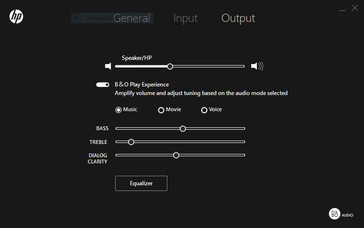
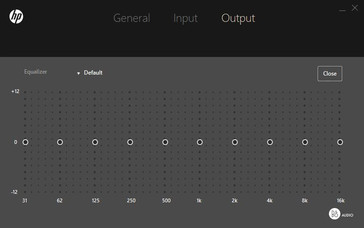
HP Pavilion x360 15t X3W72AV audio analysis
(-) | not very loud speakers (71.4 dB)
Bass 100 - 315 Hz
(±) | reduced bass - on average 14.3% lower than median
(-) | bass is not linear (15.6% delta to prev. frequency)
Mids 400 - 2000 Hz
(+) | balanced mids - only 3.7% away from median
(±) | linearity of mids is average (9.9% delta to prev. frequency)
Highs 2 - 16 kHz
(+) | balanced highs - only 3.9% away from median
(+) | highs are linear (6% delta to prev. frequency)
Overall 100 - 16.000 Hz
(±) | linearity of overall sound is average (24% difference to median)
Compared to same class
» 84% of all tested devices in this class were better, 6% similar, 10% worse
» The best had a delta of 5%, average was 17%, worst was 45%
Compared to all devices tested
» 71% of all tested devices were better, 6% similar, 22% worse
» The best had a delta of 4%, average was 24%, worst was 134%
Lenovo Yoga 510-15IKB 80VC000XGE audio analysis
(±) | speaker loudness is average but good (72 dB)
Bass 100 - 315 Hz
(-) | nearly no bass - on average 25.5% lower than median
(±) | linearity of bass is average (11.2% delta to prev. frequency)
Mids 400 - 2000 Hz
(+) | balanced mids - only 2% away from median
(±) | linearity of mids is average (7.5% delta to prev. frequency)
Highs 2 - 16 kHz
(+) | balanced highs - only 0.7% away from median
(+) | highs are linear (2.3% delta to prev. frequency)
Overall 100 - 16.000 Hz
(±) | linearity of overall sound is average (19.5% difference to median)
Compared to same class
» 62% of all tested devices in this class were better, 8% similar, 30% worse
» The best had a delta of 5%, average was 17%, worst was 45%
Compared to all devices tested
» 48% of all tested devices were better, 7% similar, 45% worse
» The best had a delta of 4%, average was 24%, worst was 134%
Frequency Comparison (Checkbox selectable!)
Graph 1: Pink Noise 100% Vol.; Graph 2: Audio off
Energy Management
Power Consumption
Thanks to Kaby Lake, the laptop doesn't draw much energy at all. On average, our device sips about 7.9 Watts at idle and 25.4 Watts under load. Power draw while idle is about 5-10% higher than the competition, mostly due to the power requirements for the HDD. The SSD in the Lenovo Yoga 710, for instance, requires less wattage when not in use.
Under load, Kaby Lake shows its benefit; the older Skylake model pulls about 17% more power when strained. Our Pavilion also consumes less power under load than the rival devices, which require an additional 20% on average.
The included power adapter is rated at a maximum of 45 Watts, which is more than enough to power and charge the notebook.
| Off / Standby | |
| Idle | |
| Load |
|
Key:
min: | |
| HP Pavilion x360 15t X3W72AV i5-7200U, HD Graphics 620, , IPS, 1920x1080, 15.6" | HP Pavilion 15-bk001ng x360 6200U, HD Graphics 520, WDC Slim WD10SPCX-21KHST0, IPS, 1920x1080, 15.6" | Lenovo Yoga 510-15IKB 80VC000XGE i5-7200U, Radeon R7 M460, Samsung MZYTY256HDHP, IPS, 1920x1080, 15.6" | Lenovo Yoga 710-14IKB 80V4002HGE i5-7200U, HD Graphics 620, Samsung MZYTY256HDHP, a-Si WLED TFT, IPS, 1920x1080, 14" | Dell Inspiron 15 5568 6500U, HD Graphics 520, Toshiba THNSNK256GCS8, IPS, 1920x1080, 15.6" | |
|---|---|---|---|---|---|
| Power Consumption | -2% | -11% | 7% | 2% | |
| Idle Minimum * (Watt) | 5.3 | 4.3 19% | 3.9 26% | 3.7 30% | 4.34 18% |
| Idle Average * (Watt) | 7.9 | 8.2 -4% | 7.8 1% | 7.16 9% | 7.5 5% |
| Idle Maximum * (Watt) | 9.7 | 9 7% | 8.4 13% | 8.3 14% | 8.4 13% |
| Load Average * (Watt) | 25.4 | 29.8 -17% | 37 -46% | 30.4 -20% | 30.4 -20% |
| Load Maximum * (Watt) | 31.2 | 36.4 -17% | 46 -47% | 30.3 3% | 32.5 -4% |
* ... smaller is better
Battery Life
The 3-cell 48 Wh battery allows for average runtimes. In our Battery Eater Classic test, the laptop shuts down after 1 hour 44 minutes. In the more realistic WLAN v1.3 test (where the notebook is set under the energy saving profile, the screen is set to 150 cd/m2, and a script opens a new web page every 40 seconds), the Pavilion lasts for 6 hours and 6 minutes, which is somewhat surprising given the 6 hour 41 minute runtime of its predecessor. Multiple runs confirm that the updated Pavilion shuts down at around 6 hours.
These runtimes are disappointing given Kaby Lake’s promised improvements in battery life and power efficiency. The shorter runtime might be due to either different background processes present in our Kaby Lake model or the hard drive, which runs even when the machine idles. The Lenovo Yoga 710-14IKB lasts over 3 hours longer in normal usage despite a similarly sized battery.
| HP Pavilion x360 15t X3W72AV i5-7200U, HD Graphics 620, 48 Wh | HP Pavilion 15-bk001ng x360 6200U, HD Graphics 520, 48 Wh | Lenovo Yoga 510-15IKB 80VC000XGE i5-7200U, Radeon R7 M460, 35 Wh | Lenovo Yoga 710-14IKB 80V4002HGE i5-7200U, HD Graphics 620, 53 Wh | Dell Inspiron 15 5568 6500U, HD Graphics 520, 42 Wh | |
|---|---|---|---|---|---|
| Battery runtime | 10% | -13% | 40% | -20% | |
| Reader / Idle (h) | 10.8 | 16 48% | 7.5 -31% | ||
| WiFi v1.3 (h) | 6.1 | 6.7 10% | 5.3 -13% | 9.4 54% | 5 -18% |
| Load (h) | 1.8 | 2.1 17% | 1.6 -11% |
Pros
Cons
Verdict
The updated HP Pavilion x360 15t is a mixed bag; while there are definite improvements in the keyboard and processor, there are compromises in the display and battery life. The Pavilion makes for a good office device, as the Kaby Lake Core i5 is more than powerful enough to handle rudimentary work and multitasking. For media consumption, however, the lackluster screen is only passable and not pleasant for long video sessions. While the 2-in-1 capabilities of the device are nice, the notebook as a whole is simply too large and heavy to use as a tablet for extended periods. The convertibility feels tacked on and isn't very useful.
The biggest compromise is the slow storage. The 5400 RPM HDD is horribly outdated by today's standards and relegates an otherwise adequate notebook to mediocrity. Coupled with a shoddy trackpad, a dim and flat screen, and difficult maintenance, it's hard to recommend the Pavilion. Most of the advantages are purely aesthetic; the Pavilion suffers in areas that really matter. At this price point, the competition offers devices equipped with the same Kaby Lake processor but faster SSDs, and these laptops are much better for the same money spent.
At $800 USD, the HP Pavilion x360 15t is a missed opportunity. The Kaby Lake upgrade is very welcome but is not enough of an improvement to justify purchase. Users should look elsewhere for a large 2-in-1 device, such as the Lenovo Yoga 710-14IKB.
HP Pavilion x360 15t X3W72AV
- 12/22/2016 v6 (old)
Sam Medley




